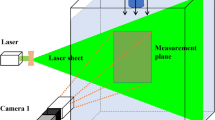Abstract
A novel procedure for tracking the propagation of the corona observed after the impact of liquid drops on thin films is proposed for the case of non-normal drop impacts. Three-dimensional adaptive-grid simulations are performed for different impingement angles and Weber numbers. In the numerical model, the Navier-Stokes equations are complemented with the Volume-Of-Fluid (VOF) method to model the gas-liquid interface. In the considered cases, the main features of the corona dynamics determined using the proposed technique are consistent with the three-dimensional description of the flow.








Similar content being viewed by others
References
Worthington AM (1908) A Study of Splashes. Longmans, Green, London
Yarin AL, Weiss DA (1995) Impact of drops on solid surfaces: self-similar capillary waves and splashing as a new type of kinematic discontinuity. J Fluid Mech 283:141–173
Weiss DA, Yarin AL (1999) Single drop impact onto liquid films: neck distortion, jetting, tiny bubble entrainment and crown formation. J Fluid Mech 385:229–254
Purvis R, Smith FT (2004) Large droplet impact on water layers. AIAA Paper, 2004-414
Hammond DW et al (2005) Analysis and experimental aspects of the impact of supercooled water droplets into thin water films, AIAA Paper, 2005-0077
Quero M et al (2006) Analysis of super-cooled water droplet impact on a thin water layer and ice growth, AIAA Paper, 2006-466
Rieber M, Frohn A (1999) A numerical study on the mechanism of splashing. Int J Heat Fluid Flow 20:455–461
Nikolopoulos N et al (2007) Three-dimensional numerical investigation of a droplet impinging normally onto a wall film. J Comput Phys 225:322–341
Brambilla P et al Grid convergence assessment for adaptive grid simulations of three-dimensional drop impacts on liquid films, submitted to Mathematics and Computers in Simulations
Hirt CW, Nichols BD (1981) Volume of fluid (VOF) method for the dynamics of free boundaries. J Comput Phys 39:201–225
Brackbill JU et al (1992) A continuum method for modelling surface tension. J Comput Phys 100: 335–354
Jasak H (1996) Error analysis and estimation for the finite volume method with applications to fluid flows, PhD. Thesis, Imperial College, University of London.
Jasak H, Gosman AD (2000) Automatic resolution control for the Finite Volume Method. Part 2: adaptive mesh refinement and coarsening. Num. Heat. Trans.Part B: Fundamentals 38(3):257–271
Okawa T et al (2008) Effect of the impingement angle on the outcome of single water drop impact onto a plane water surface. Exp Fluids 44:331–339
Brambilla P et al (2012) Numerical simulation of non-normal drop splashing using an adaptive scheme, MASCOT 2012 Conference. Gran Canaria, Spain
Author information
Authors and Affiliations
Corresponding author
Rights and permissions
About this article
Cite this article
Brambilla, P., Guardone, A. Automatic tracking of corona propagation in three-dimensional simulations of non-normal drop impact on a liquid film. Computing 95, 415–424 (2013). https://doi.org/10.1007/s00607-012-0271-3
Received:
Accepted:
Published:
Issue Date:
DOI: https://doi.org/10.1007/s00607-012-0271-3




